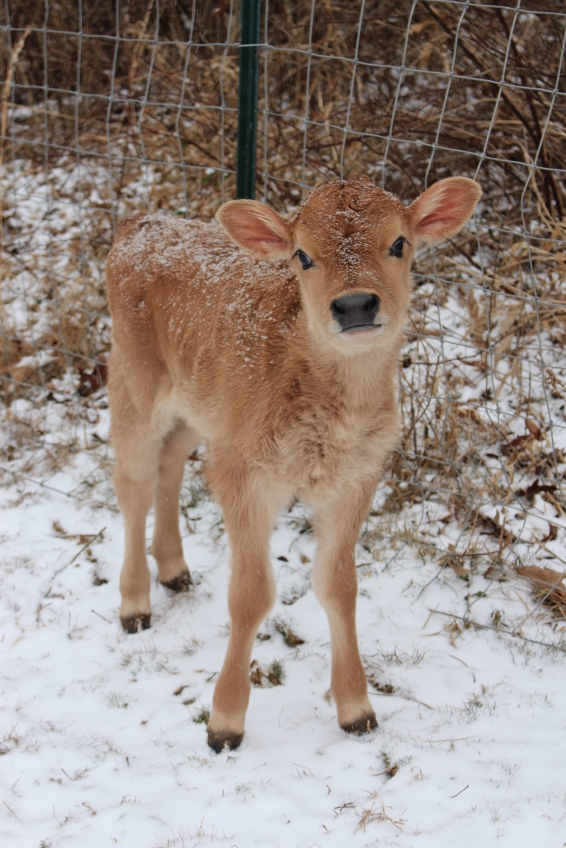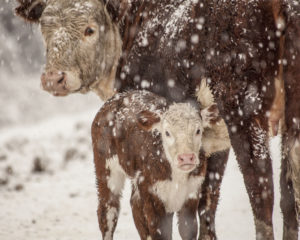Adjusting Calf Feeding as the Weather Grows Colder
Helping calves adapt to winter conditions by altering feeding regimes is essential to help calves grow to their full genetic potential, experts from Purina Animal Nutrition say.
Winter is fast approaching, and that means your calves’ nutrient requirements are changing. The amount of energy needed to grow and support the immune system changes, depending upon the temperature.

By adjusting for the weather we can expect to see better performing calves.
Transition
Calves should be switched to a cold weather feeding program when the temperatures are consistently below their thermoneutral zone. When cattle are in their thermoneutral zone, they do not have to expend extra energy to maintain a constant core body temperature.
For calves fewer than 21 days old, cold stress can begin when temperatures dip below 60° F . Calves more than 21 days of age start to experience cold stress when temperatures dip below 40° F. A 10-mile-per-hour wind can create cold stress even when the air temperature is 40 F and the cattle have a dry winter hair coat. For every one degree below the critical temperature, a cow’s energy requirement increases one percent.
The timing will vary based on geography and age of calves, but once the temperature hits the calves’ lower critical temperature and stays consistent, that’s the time to switch.
When making the transition there are several options to consider.
- Option 1: Start feeding seasonal milk replacer to the new or incoming calves and not switch all of the calves to the seasonal formula.
- Option 2: Gradually add the seasonal milk replacer, mixing it with the regular milk replacer until calves are receiving 100 per cent seasonal milk replacer. Start by adding 20-25 per cent of the seasonal milk replacer per day over 4-5 days.
“Avoid switching milk replacers “cold turkey” as it is best to keep the diet consistent as possible for calves,” said Mr Denton.
A seamless switch

It’s important to weigh milk replacer at every feeding to provide a consistent diet for the calf, but it becomes critical when switching between seasonal products, Mr Denton advises.
The fat and protein content of seasonal formulas have been optimized to meet the calves’ needs during cold weather.
As a result the seasonal milk replacers can have different densities. If using automated feeders, make sure to calibrate them when switching to a new milk replacer.
Steps to avoid the winter ‘slump’
Nutrition is of utmost importance, but experts advise considering these additional factors when dealing with cold weather conditions:
- Colostrum – Calves are born with 4 per cent body fat, making the fat in colostrum an essential source of energy for the newborn calf.
- Bedding – An effective mechanism to minimize heat loss, deep, clean and dry straw will allow the calf to nest, trapping a boundary layer of warm air around itself.
- Calf jackets – If the temperature is below 60° F, consider putting calf jackets on newborn calves. For older calves (21 days old), look to implement calf jackets when temperatures dip below 40° F. Be sure to adjust the fit of the jacket over time as the calf grows.
- Warm, fresh, free-choice water – Water consumption helps improve starter intake and supports rumen development in those early weeks of life, and a well-developed, functioning rumen generates heat which helps keep calves warm. Offering warm water to calves also conserves energy, as they don’t have to expend energy to warm it up to their core body temperature.
- Consistent feeding intervals – Feed calves a milk diet at even intervals of 2 times or 3 times to avoid extended time between feedings. When there is a 14-16 hour interval between feedings calves can be exposed to the coldest time of the day with empty bellies.
- Seasonal starters – Consider feeding a seasonal calf starter, which provides higher energy levels to meet a calf’s higher energy requirements in the winter months.
- Minimize stress – It may seem obvious, but minimizing stress during a period of cold weather will help calves conserve energy. It’s as simple as closing a calf barn door behind you or reducing handling time.
To gain overall healthier calves and reduced treatment costs. a seasonal feeding program must become part of a full potential nutritional program that gives calves the nutrients they need to support their immune system and grow to their full genetic potential.
